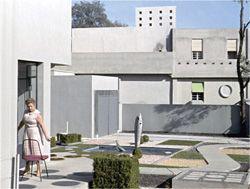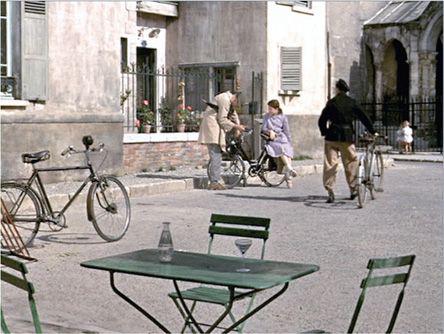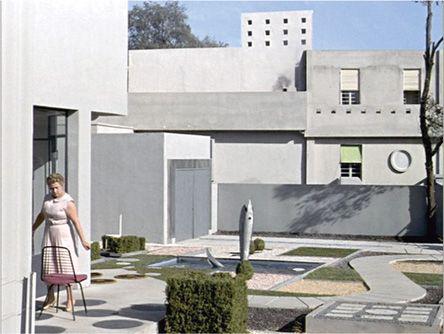B0041VYHGW EBOK (127 page)
Authors: David Bordwell,Kristin Thompson

www.filmmusic.com
News of current releases, along with interviews with composers and music crew.
www.filmscoremonthly.com
magazine site with some free articles.
www.geocities.com/Hollywood/Academy/4394/sync.htm
In this 1995 article, “Sync Takes: The Art and Technique of Postproduction Sound,” Elizabeth Weis concisely explains the creative choices involved in sound mixing. Our quotation from Michael Kirchberger is taken from one of the comments Weis presents here.
Recommended DVD Supplementswww.npr.org/templates/story/story.php?storyId=1126863
A streaming audio interview with Walter Murch on the National Public Radio program
Fresh Air.
ADR, the postdubbing of dialogue, seldom finds its way onto DVD supplements. An exception comes in “Peter Lorre’s ADR Tracks” on the
20,000 Leagues Under the Sea
DVD. (The track is well hidden: in the “Bonus Material” section, click right to “Lost Treasures” and then choose “Audio Archives #2.”) The opposite technique, recording songs for playback and lip-synching on set during the filming of musical numbers, is demonstrated in “Scoring Stage Sessions” on the
Singin’ in the Rain
disc.
An excellent survey of how sound tracks are built up is “On Sound Design,” for
Master and Commander,
where a dense ambient mix had to support the portrayal of a crowded ship. This supplement shows why so much dialogue recorded during filming is not usable and must be replaced by ADR. Sound-effects specialists demonstrate the subtleties of re-creating the noises from firing from various types of weapons.
The “Sound Design” section of “Music and Sound” on the
Toy Story 2
supplements includes a clear example of how sound functions within scenes. In the scene where the band of toys crosses a street full of traffic, the filmmakers’ goal was to create extreme contrasts between movement and stasis. One technique was to stop and start the music as the toys froze and then moved on. The scene is played through with only sound effects, only music, and the final mix.
Each volume of
The Lord of the Rings
offers a supplement called “The Soundscapes of Middle-Earth,” with the three adding up to about an hour. The
Fellowship of the Ring
documentary discusses ADR as well as sound effects. Each volume also contains a segment, “Music for Middle-Earth,” totaling about an hour. The
Two Towers
DVD set contains a demonstration of sound mixing, with eight versions of the same clip from the Helm’s Deep battle: one with the sound recorded on-set during filming, six with selected parts of the sound (music in one, weapon sounds in another, and so on), and the final mix. The six incomplete tracks have already been partially mixed from separate recordings. Originally, each sound was recorded separately. Early in
The Return of the King,
for example, as Gandalf leads the group through the woods to visit Isengard, one track was made just for the clicking of Legolas’s arrows in his quiver—a sound barely distinguishable in the final mix.
Discussions of musical scores are among the most common of making-of supplements. In a particularly detailed and systematic discussion, “Scoring
War of the Worlds,
” John Williams comments extensively on the narrative functions of his music. The supplement was directed by Steven Spielberg. In the “Music” supplement for
The Golden Compass,
composer Alexandre Desplat discusses musical motifs; he also talks about the exotic instruments he chose to characterize the various ethnic groups in the story. Hans Zimmer, composer for
The Dark Knight,
describes the dissonant music associated with the Joker character in “The Sound of Anarchy” supplement.
Sergio Leone’s Westerns are often called “operatic,” and film music historian Jon Burlingame explains why in “Il Maestro: Ennio Morricone and
The Good, the Bad, and the Ugly.
” Unlike most movie music, the scores for Leone’s films were written in advance, and this supplement explains how the music guided the director during shooting and editing.

At the beginning of
Part Two
, we saw how the different parts of a film relate to one another dynamically within its overall
form.
Now, having examined each category of techniques of the film medium, we may go on to see how these techniques interact to create another formal system of the film, its
style
. These two systems—style and narrative/non-narrative form—in turn interact with each other.
Stylistic patterns are a major part of any film. Sometimes, though, we talk about style in several films by the same filmmaker. We looked at
Our Hospitality
in terms of how its comic mise-en-scene is organized around a consistent use of long shots; this is part of Buster Keaton’s style in other films, too. Many filmmakers have distinctive styles, and we can become familiar with those styles by analyzing the way in which they utilize techniques within whole filmic systems.
Further, we can also speak of a
group style
—the consistent use of techniques across the work of several filmmakers. We can speak of a German Expressionist style, or a Soviet montage style. In
Part Six
, we will consider some significant group styles that have emerged in film history.
“The choices you make push you in a certain direction, and that becomes what people call style.”
—Chris Doyle, cinematographer,
Chungking Express
No single film uses all the technical possibilities we’ve discussed. For one thing, historical circumstances limit the choices that filmmakers have open to them. Before 1928, for example, filmmakers did not have the option of using synchronized dialogue. Even today, when the range of technical choices seems far broader, there are limits. Filmmakers cannot use the now obsolete orthochromatic film stock of the silent era, although in some respects it was superior to contemporary stocks. Similarly, a successful system for creating three-dimensional cinema images without the necessity for spectators to wear special glasses has yet to be invented.
There is another reason only some technical possibilities may be realized in a single film. As we saw in
Chapter 1
, working in a concrete production situation, the filmmaker must choose what techniques to employ. Typically, the filmmaker makes certain technical choices and adheres to them throughout the film. Across the film, a filmmaker will characteristically use three-point lighting, or continuity editing, or diegetic sound. A few segments might stand out as varying from the film’s normal usage, but in general, a film tends to rely on consistent usage of certain techniques. The film’s style results from a combination of historical constraints and deliberate choices.
Filmmakers also deliberately select techniques that will point out story parallels. Piotr Sobocinski, cinematographer for Krystyf Kieslowski, says that in
Three Colors: Red,
a crane shot down to a fashion show was designed to recall an earlier camera movement, when the camera craned down as a book fell into the street. Similarly, in filming
Viva Zapata!
Elia Kazan tracked in on Zapata, who is ignoring the fact that a crowd of peasants is marching with him: “We had to go close on that shot and dolly [i.e., track] because what I wanted to show was his expression or lack of expression. We later contrasted that with a similar dolly shot on the police chief beginning to notice what was happening. The point was to contrast those two attitudes.”
CONNECT TO THE BLOG
We trace the stylistic and formal development of a major contemporary filmmaker in “The sarcastic laments of Béla Tarr,”
at
www.davidbordwell.net/blog/?p=1315
.
For the style of two art film directors of the previous generation, see “Bergman, Antonioni, and the stubborn stylists,” at
www.davidbordwell.net/blog/?p=1139
.
Films setting up strong narrative contrasts will often reinforce them with sharp stylistic differences. Jacques Tati’s
Mon Oncle
opposes the charm of old Parisian neighborhoods to the sterility of the new buildings that replace them. Mr. Hulot lives in a ramshackle apartment building on a quiet little square, while the Arpel family—Hulot’s sister, brother-in-law, and nephew—have just moved into an ultramodern house full of high-tech gadgets and chic but uncomfortable furniture. Scenes in Hulot’s neighborhood tend to be accompanied by jaunty music, except when sound effects or dialogue become important. In this locale, the camera stays outside his apartment, stressing the interactions of the many people living and working around the square
(
8.1
).
By contrast, the Arpel scenes contain no music. Instead, we hear the tapping of shoes on stone floors and the clicks and whirs of the absurd appliances. There are frequent shots inside the house, and the street is almost invisible behind the family’s metal security fence
(
8.2
).

8.1
Mon Oncle.
Mr. Hulot chats with a neighbor while other people pass nearby.

8.2 The Arpels’ inconveniently laid-out garden, with a giant metal security door that blots out their view of the street.
Many filmmakers plan the overall style of the film to reflect the progression of the story. For
Dead Man Walking,
Tim Robbins and his cinematographer, Roger Deakins, worked out a visual pattern to convey the increasing intimacy between the characters played by Susan Sarandon and Sean Penn, who talk to each other in a string of interviews spread across the film. Early scenes were shot to emphasize the wire mesh between the two, keeping it in focus and the Penn character more distant. Later, using longer lenses and slow tracking shots, the scenes minimize the barrier. Ultimately, when the characters are communicating through a cell door, reflections in the window make each one visible in the other’s shot. As usual, repetitions and differences are used to shape our experience of the film.
The spectator has a relation to style as well. Although we’re seldom conscious of the fact, we tend to have expectations about style. If we see two characters in a long shot, we expect a cut-in to a closer view. If the actor walks rightward, as if about to leave the frame, we expect the camera to pan or track right to keep the person in the shot. If a character speaks, we expect to hear diegetic sound that is faithful to its source.
